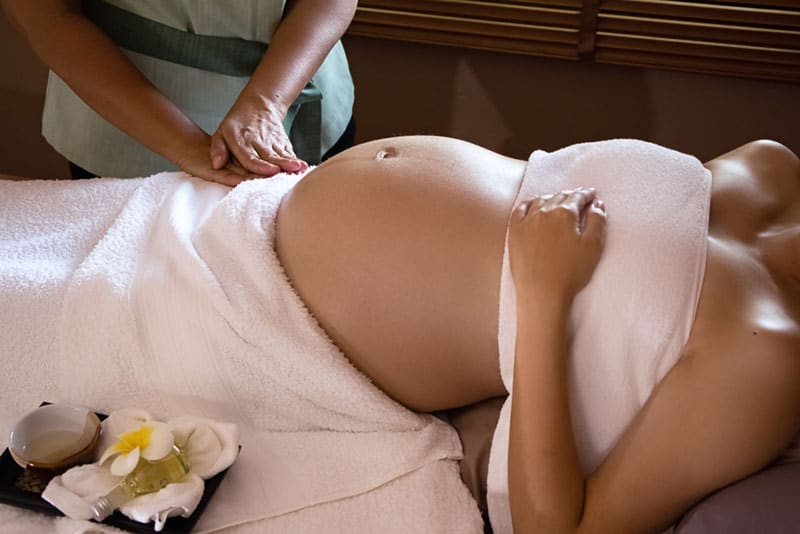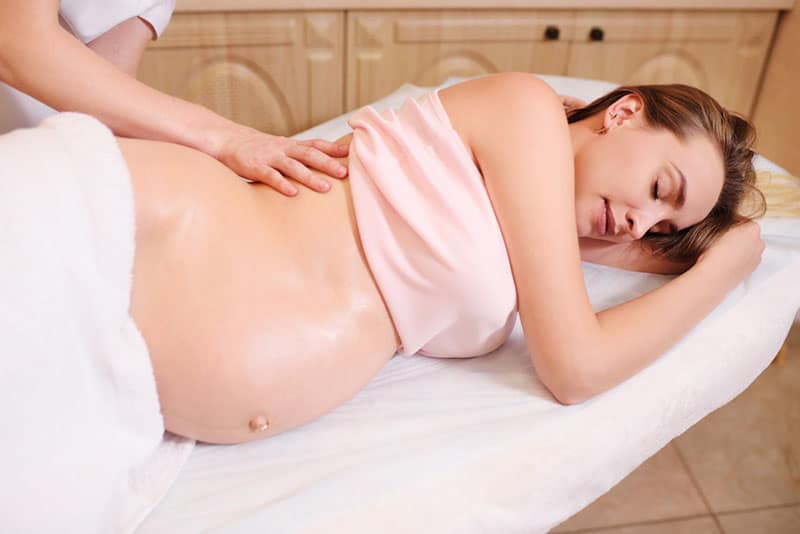The idea of getting a massage while you’re pregnant may sound ludicrous to some moms, but a maternity massage is a very safe method of enjoying the relaxing benefits of massages without having to worry about child safety.
A maternity massage, also known as a prenatal massage, is one where special care is taken care of pregnant women so as not to cause any potential harm to the mother or baby.
It’s a form of massage therapy where the prenatal massage therapist receives special training and uses special harnesses and techniques to help provide relaxation and tension relief to expectant mothers.
What risks are there, you may ask?
Well, in a typical massage, you have to lie face down and on your belly for a time – a near impossibility for a pregnant woman.
That is, unless the therapist has a specially equipped table with a hole and cushions ready to house your growing belly.
The risk of simply lying flat on your back is also a very serious one, hence why normal massages aren’t recommended due to the risk of the added pressure pinching down on a blood vessel.
This, in turn might cause stronger dizzy spells or enhance the feelings of morning sickness for a few days.
Luckily, maternity massage therapists have all pregnant mammas covered. Lets see how exactly all of it’s done, shall we?
When Can You Have A Maternity Massage?

Much like many other activities when pregnant, it’s recommended to wait until you at least transition away from the first trimester and are at least a bit into the second trimester.
This is mostly for your own well-being due to the aforementioned problems of intensified morning sickness and dizzy spells, in which case they do more harm than good.
Once you’ve safely crossed into the second trimester, don’t go to a massage off your own whims, seek advice from your doctor or your practitioner so they can confirm that it’s safe for you to get one.
You should also make sure to notify the massage therapist that you’re pregnant so they can take all of the necessary measures, as well as confirm that they are actually trained in this specific form of massage.
Unlike a regular massage (also known as a Swedish massage), a maternity massage requires some extra training and licensing that goes through the American Massage Therapy Association (AMTA) so one could earn a certification in postpartum and/or prenatal massage.
All of it mostly boils down to extra training that’s needed, so be sure to ask before booking any massage sessions.
This way you won’t end up disappointed when you realize you’ve potentially wasted your money and their time.
Is A Pregnancy Massage Safe And What Are The Risks (If Any)?

While massages are relatively safe when you’re not pregnant, getting one while pregnant isn’t exactly safe if the person doesn’t know what they’re doing.
Not to say that they’re potentially fatal or anything, but if the therapist or any other person uses the wrong massage techniques and actually relies on a regular massage, you may experience some difficulties.
These could include feeling dizzy or nauseous throughout the ordeal and a few days after, but those risks are greatly reduced or the effects are greatly stifled if you get the massage at the right time.
Deep tissue massages are also avoided, at least around the legs. It’s because when women become pregnant, blood clots are more likely to manifest in the thigh area.
And, engaging in a deep tissue massage around that area is very likely to dislodge them and have them cause unnecessarily risky complications. If you must, stick to deep tissue work around your shoulders instead.
There are certain other areas on the body that certified massage therapists tend to avoid as well. Those are usually the same spots that acupuncture specialists avoid.
These so-called acupressure points are most often found around the heel or ankles and having them triggered has the potential to cause preterm contractions, something you definitely don’t want.
While it hasn’t been scientifically proven yet, or rather, not enough tests have yet been conducted to warrant that claim, it’s still better to be safe than sorry.
The other, more obvious area that’s avoided is your stomach, or rather, the entirety of your abdominal area.
That’s because unnecessary pressure applied to it is only going to end up making you sick or uncomfortable rather than actually helping with anything.
Also, remember when I mentioned the problems that lying flat on your back can cause during early pregnancy?
Well, during the second and third trimesters, an additional issue pops up when you’re lying on your back and that’s putting your baby in distress due to the added weight.
This weight presses down on your blood vessels and compresses them, which, in turn, slows down blood circulation and reduces the amount of oxygen flow to the placenta, leaving the baby starved of it. This could lead to potentially irreparable consequences.
Do be sure to always be at least a bit elevated when lying down or get into a side-lying position to allow for unrestricted blood flow (to an extent).
There’s always the risk of dealing with an untrained massage therapist to which the solution is to simply ask.
See that they at least have around 16-18 hours of training done so that you can be confident enough in their skills to perform a prenatal therapeutic massage on you.
And, of course, before any massage, make sure to check with your doctor or other certified healthcare provider whether or not a maternity massage is the right thing for you.
As much as a good massage can benefit you, you may have some sort of pre-existing complication at the time that can make these potential risks even worse to deal with.
Here are a few good examples of conditions that, if you have, you should avoid having a prenatal massage done to you:
• diabetes
• high blood pressure
• heavy abdominal pain
• abdominal bleeding
• an illness
• high fever
• preeclampsia
• nausea or morning sickness
These are just a few examples, so just make sure to ask your doctor first in any case and he’ll be able to determine whether or not you’re cleared to take a massage.
Benefits Of Prenatal Massages

While there are many potential risks to getting a maternity massage, most of them come from poor timing and can be avoided if all the proper prerequisite steps are taken.
Once these are done, you can finally reap the benefits!
Much like with any massage, a prenatal massage serves to help loosen the tension in your body due to the added weight and other challenges that come with being pregnant.
It’s also a great form of stress relief for that very reason, as it helps reduce the amount of stress hormones that your body produces and puts you in a more serene state.
That, in turn helps you focus more, helps you come to grips with your pregnancy, and keeps you centered.
This makes it harder for any panic to set in and shows you that these pregnancy problems aren’t as scary as you might have initially thought.
Some even claim that these maternity massages can help stave off depression, the main plague of the modern world, and encourage more positivity.
Another benefit of maternity massages is that they help your cardiovascular system normalize by increasing blood flow to all parts of the body, which is an especially good thing if you’re suffering from low blood pressure or something similar.
But, that’s not all, they also aid in maintaining the lymphatic systems functions by helping it detox you and keep your body clean of anything that might be making you unwell or worse.
Outside of that, there are the more obvious functions shared with regular massages, such as helping relieve back pain, both in the upper and lower back, though the latter is more common.
Knowing how the life of expecting mothers turns into a more sedentary one, you might also be more prone to leg cramps, sprained ligaments, and joint pain in general. A proper medical massage is going to help alleviate all of those symptoms as well – if done regularly enough, that is.
The same can be said for sciatica pain, which is when your sciatic nerve ends up being pincered due to too much sitting.
Even the most active of moms are prone to this one, given the added pressure on the lower back area.
Luckily, it’s nothing that a good maternity massage can’t fix.
Then, there are all of the common pregnancy problems you’re likely to encounter like carpal tunnel, the swelling of your limbs, or symptoms of a sinus infection, namely congestion and headaches.
All of these can be alleviated through proper massage therapy and treatment.
As for postpartum massages, similar benefits stand but also include helping bring your hormone levels back to normal a lot quicker.
Not only that, but a good postnatal massage can also help resolve sleep issues (something you’ll greatly appreciate when you have a newborn child).
They’re also known to help promote milk production if you’re struggling with it.
Can Prenatal Massages Be Performed At Home?

They actually can. Your marriage partner or even your doula can perform one for you if they’ve received the necessary training to do so and you have an appropriate place where it can be performed.
They should stick to your back area, shoulders and scalp as far as the actual massage is concerned, and not try much else that’s riskier.
In any of these cases, a gentler touch is needed.
Think of it as some extra intimate time with your beloved partner – a trip to your very own, at-home day spa and wellness center.
As far as the back is concerned, have them focus on your muscles and knead it softly like a piece of dough, not pushing too hard, and using their thumb or the padded area underneath it only, rather than the whole hand.
Regarding the shoulders, have them massage the muscles found around the holes of the collar bone, as those tend to be the main cruxes of tension in the upper back area.
The other prime spots for a prenatal massage are the muscles on the sides of the back of the neck, and at the base of the skull.
A gentle touch there might not provide as much relief as that of a deep tissue massage, but believe me when I say that it’ll feel like you’re in heaven regardless.
Finally, the scalp massage is rather simple. Have them focus more on the indents on the side of the skull and at the base where the softer spots are and large clumps of nerves.
Having gentle pressure applied to them and having them caressed is nothing short of ecstasy when done properly and will feel like all your troubles are melting away.
As for the feet and stomach, don’t massage them.
Instead, you can grab some vitamin E oil for the tummy and lather it in gently in order to help prevent stretch marks from forming.
When it comes to the feet, try avoiding the aforementioned acupressure points and stick to just gently caressing the top of the foot.
Something that will enhance the experience in these homemade massages is to get some lotion or pregnancy-safe oils. It’ll end up feeling much better even if your partner has rougher hands.
In Conclusion
A maternity massage, especially prenatal massages, are a bit different than regular, Swedish ones.
They require different forms of positioning for the expecting mother to help prevent any downsides to mom and baby, and take at least a dozen or so hours to be qualified to perform one.
Despite these prerequisites, the process is rather easy to learn and to perform on another. The key to it is to be gentler than you would be while administering a regular massage.
The benefits are very much worth it and the drawbacks are practically non-existent if you’re prepared properly for them.
While a maternity massage can help make the whole process of pregnancy a much more pleasant one, do remember to always ask your doctor or any other certified health care provider if you can take one, as some complications might make the experience less than enjoyable.
If you have all of that taken care of, I wholeheartedly recommend going for them regularly – you won’t regret the money you put into them, not one bit!
I speak from personal experience, as a massage parlor that performs maternity massage near me made my pregnancy so much easier to manage with regular sessions.
READ NEXT: Self Fertility Massage: Benefits, Types And Techniques
Like this post? Please share or pin it for later. You can also stay in the loop and follow us on Facebook, Instagram or Pinterest.

This post contains affiliate links. Please see our full disclosure for more info.

